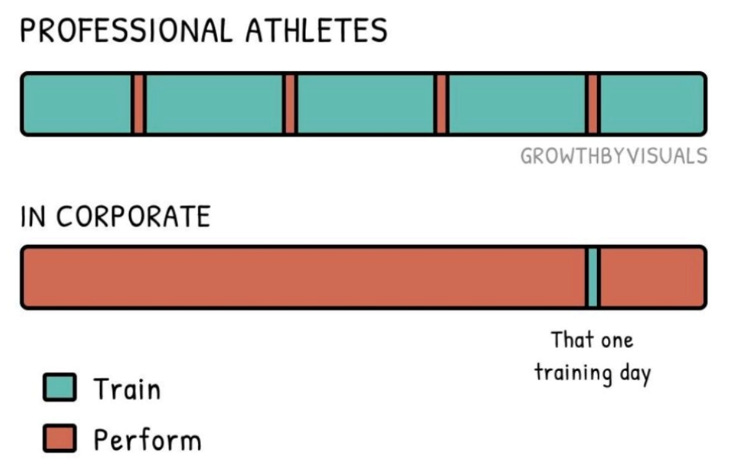Last week, whilst scrolling through LinkedIn, I came across this graphic, shared by Joseph Calabro, a Senior Financial Analyst. I don’t know anything about Joseph, or what Senior Financial Analysts do, but the image resonated. The top image describes how top athletes get better. Training is frequent, regular and lengthy in comparison to performance. By contrast, in the corporate world most of the time is spent ‘performing' i.e. doing the job, with irregular and short lived periods of training. This made me reflect on teacher professional development.
The bottom model is still reflective of the experience of many teachers. For months, they perform in lessons, day in and day out. They will then come to an INSET day - labelled on the diagram as ‘that one training day’. This will involve some kind of input from somebody, who will give them some pearls of wisdom about something. The INSET day will come to an end and they will go back to their lessons the following day. The chances are, very little will change with their teaching as a result of the INSET day.
This is not a criticism of teachers. Far from it. It’s a criticism of this model of training. Very little changes because:
The input may not have been contextualised to subjects.
Subject teachers haven’t had the opportunity to discuss what this approach might look like in their subject.
The approaches discussed may not have been modelled to teachers.
Teachers may not have had the opportunity to rehearse the new approach.
There hasn’t been any opportunity to revisit the new approach.
Nobody is encouraging the teacher to ‘give it a go.
Nobody is giving the teacher useful feedback on how they are doing with the new approach.
This is problematic, if we’re serious about helping teachers to get better. At Durrington, we’ve tried to address this by calendaring in regular and subject specific professional development.
Every fortnight, curriculum teams meet during a ‘Subject Planning & Development Session’ (SPDS). During a SPDS, teachers within a curriculum team talk about ‘what are we teaching over the next fortnight and how do we teach it well?’ Clearly they can’t cover everything that will be delivered that fortnight. However, a topic that is going to be taught is identified and unpicked by the team. This might include:
Somebody modelling (in teacher mode) how they teach that topic to their peers. They will periodically break off from teacher mode, to explain and discuss why they are teaching in that way.
The opportunity for teachers to rehearse the technique and receive feedback from their peers.
Thinking about and planning really rich questions to deepen thinking with the topic.
Agreeing key tier 2 and 3 vocabulary and how it will be explicitly taught - this might include thinking about good ‘non-examples’ to use.
Discussing common misconceptions with the topics and how to navigate this with students.
Discussing and agreeing curriculum links, to support cohesion.
What the end product might look like e.g. a piece of art, and how the teaching has supported this.
There will be other approaches used in SPDS, but these are some of the key ones. We like this approach to professional development because it is:
Regular - it happens every two weeks
Subject specific - it is led by subject specialists
Relevant - it is linked to what will be taught that fortnight
We use other approaches to professional development alongside this, such as instructional coaching. Over the years however, SPDS have become a really important part of our approach to teacher development. This is because it gives teachers the time to do what most teachers really enjoy and find useful - talking about their subject and how to teach it well.
Going back to the orginal diagram at the top of this post, the time we give to SPDS isn’t comparable to the time top athletes spend training relative to performing. There simply isn’t enough time available. However, we are pretty confident that it’s better than the other model of irregular and isolated pockets of training.
Shaun Allison
Co-Headteacher, Durrington High School



Thanks Carl 👍🏼
Thanks Shaun. This might be of some interest to you. https://thatpovertyguy.substack.com/p/the-c-word-part-1